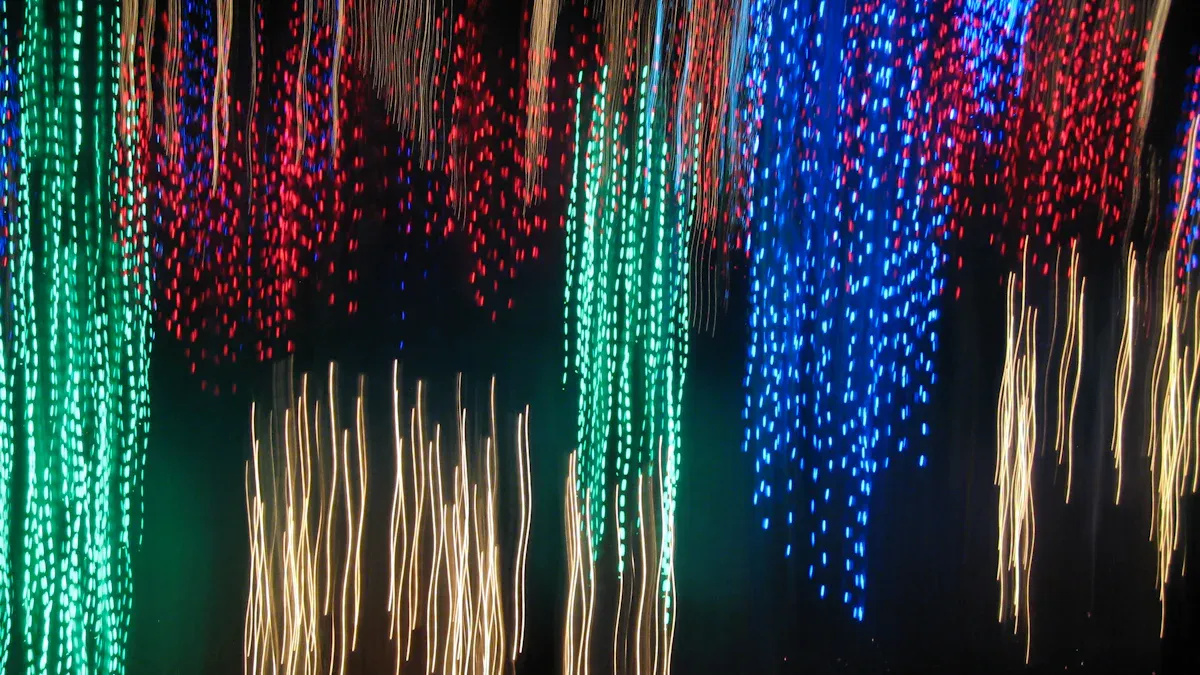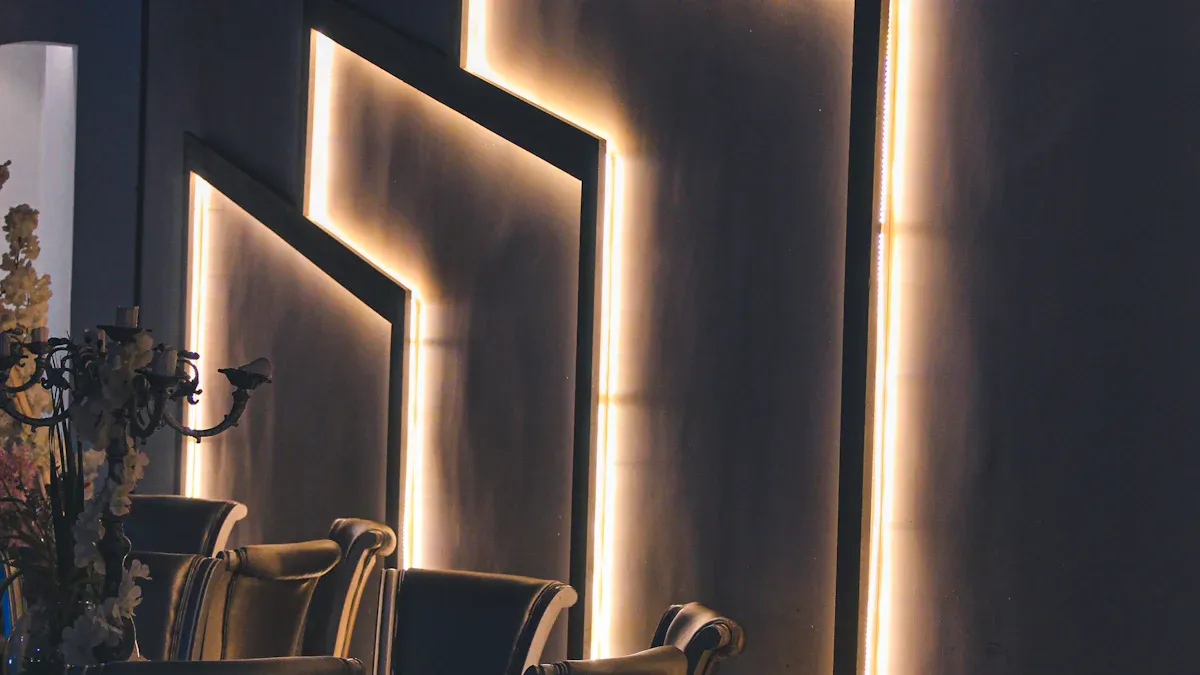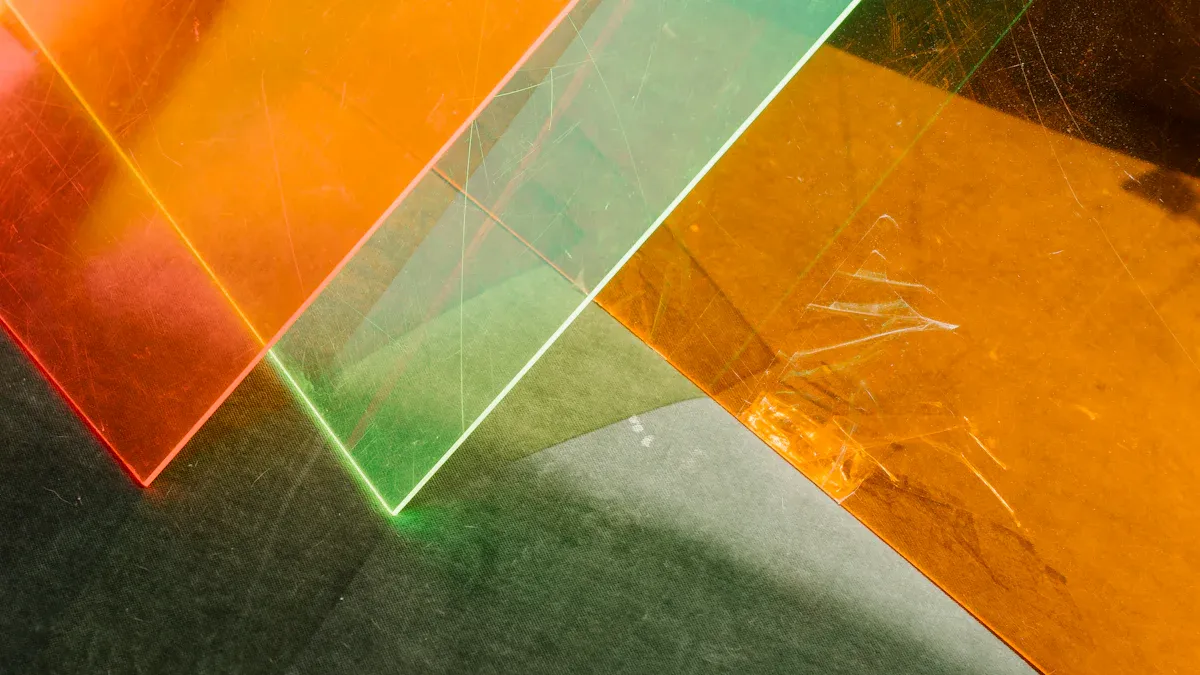Backlit Plexiglass Panels: Materials, Installation, and Design Applications

Backlit plexiglass panels use light to make surfaces glow. People use them for displays, signs, and building features. You can see these panels in many design projects. They give bright and even light. They also look smooth and modern. Designers pick them because they help spaces stand out. Reports say more people want backlit panels now. This is true in places like Asia Pacific. New technology and cities help this trend grow. Think about how backlit plexiglass panels could change your next project.
Key Takeaways
Backlit plexiglass panels give off smooth, even light. This makes rooms look modern and bright. - Using LED lights with light diffusing acrylic stops harsh spots. It also helps save energy. - Pick the right acrylic type and thickness for your design. Make sure it fits your space and needs. - Follow clear steps when you install the panels. Use the right mounting hardware for a safe setup. This helps the panels last longer. - Backlit panels are good for signs, displays, and art. They also work for ambient lighting in many places.
Backlit Plexiglass Panels

Overview
Backlit plexiglass panels use acrylic sheets that light up from behind. These panels are common in modern places because they shine with smooth, even light. Each panel has a see-through acrylic layer and a lighting system like LED strips. Sometimes, there is a diffuser to help spread the light. Acrylic materials like ACRYLITE let lots of light pass through and stop bright spots. You can cut, shape, or engrave these panels for your project. Designers often add finishes like powder coating or anodizing for more style. You can also put printed graphics or patterns on the acrylic for a special look.
Tip: Pick the right thickness and support so your panel stays strong and safe.
Benefits
Backlit plexiglass panels have many good points. They give bright, even light that makes colors and shapes pop. Acrylic spreads light well, so you do not get harsh spots or shadows. These panels use less energy than old lighting ways. LED lights last a long time and help save money on power. You can change the color or brightness to fit your mood or brand. The thin design fits in many places and does not take up much space. This makes them a smart pick for new or old buildings.
Last a long time and are easy to care for
Flexible design works in many ways
Strong visual effect for any space
Common Uses
You see backlit plexiglass panels in lots of places. They are great for signs in stores, offices, and public spots. Brands like Tesla use blue LED backlit acrylic displays for a modern look in showrooms. Fancy brands use layers of acrylic to make displays look deep and stylish. These panels are also used for wall art, ceiling lights, and room dividers. Acrylic is a top pick for signs because it is clear, easy to shape, and works inside or outside. Many companies use backlit acrylic for custom signs, halo-lit letters, and big glowing logos. These panels help you make designs that stand out and look great anywhere.
Materials
Light Diffusing Acrylic
You want your backlit acrylics to glow with soft, even light. Light diffusing acrylic is very important for this. It helps stop harsh spots and shadows from showing up. The special surface spreads the light from LED strips. This makes your panels look smooth and glowing.
Tests show light diffusing acrylic works best with wide-beam LED strips. For example, a 160° ultra-wide beam LED strip with opal or frosted acrylic gives even, dot-free light. You get bright panels without seeing each LED. Photometric tests show high color and brightness. These results come from labs with global safety and quality checks.
Note: Light diffusing acrylic helps you make safe, high-quality backlit acrylics for any project.
Backlit Acrylics Types
You have many choices for backlit acrylics. Each type has its own good points for design. Here are some popular types:
White 2447 Translucent: This acrylic spreads light very well. It gives a soft, even glow. It is great for backlit signs and displays.
White 2447 P95 Dual Finish: This sheet has a matte side. It cuts down glare and reflections. It works well in places that need soft light.
Clear P95 Dual Finish: Both sides are matte. You get clear acrylic with diffused light. It is good for panels and LED fixtures.
Clear DP9 Matte Finish: This acrylic has a special texture. It makes a unique light effect. It is perfect for creative lighting.
Translucent acrylic sheets: These sheets balance light passing through and spreading out. They are used in signs, light panels, and soft lighting.
You can use these backlit acrylics in many ways. Stores use them to make products stand out. Signs use them to be easy to read in low light. Interior designers use them for custom lights and soft lighting. You also see backlit acrylics at trade shows and events. Popup displays, modular units, and banners use these materials. They are quick to set up, easy to move, and make booths look bright.
Tip: Pick the right backlit acrylic by thinking about light diffusion, finish, and where you will use it.
Material Selection
Choosing the best materials for your backlit acrylics is important. Look at how much light passes through, how thick the sheet is, and the surface finish. These things change how your acrylic glows and how bright it looks.
Here is a table to help you compare common choices:
Acrylic Type | Light Diffusion | Surface Finish | Best Use Cases |
|---|---|---|---|
White 2447 Translucent | High | Glossy | Signs, displays |
White 2447 P95 Dual Finish | High | Matte (1 side) | Soft lighting, glare reduction |
Clear P95 Dual Finish | Medium | Matte (2 sides) | Panels, LED fixtures |
Clear DP9 Matte Finish | Medium | Textured | Creative lighting |
Translucent acrylic sheets | Balanced | Varies | Signs, ambient lighting |
You might wonder how acrylic compares to other see-through materials. Acrylic is easy to shape, cut, and engrave. It stands up to weather and stays clear for a long time. Other materials, like polycarbonate or glass, may not spread light as well or may be heavier. Acrylic gives you a strong, clear, and light-spreading choice for backlit acrylics.
When you put in your backlit acrylics, use the right mounting and LED spots. This stops bright spots and keeps your panels glowing evenly. Clean your acrylic panels with gentle cleaners to keep them clear and bright.
Remember: The right materials and careful setup help your backlit acrylics look great and last longer.
Installation
Preparation
Start your backlit project by gathering all the needed parts and tools. You need the acrylic panel, frame, LED strips, power adapter, mounting hardware, and any graphics or letters. Cut the frame and back panel to the right size. Smooth the edges and clean the acrylic sheet. Prepare your graphics or letters so they stick well and look sharp.
Follow these steps for a smooth backlit assembly:
Mark where you want to mount the panel using pre-drilled holes or a template.
Drill holes and insert dowels if needed.
Mount tensioned cables or brackets to hold the panel.
Place the LED strips evenly inside the frame.
Connect the LED wires to the power adapter. Use insulated, outdoor-rated wires for safety.
Attach the acrylic sheet and graphics. Make sure there are no bubbles or misalignment.
Secure the frame and back panel with strong tape or screws.
Test the LED lights for even glow before finishing the installation.
Mount or hang the panel using sturdy hardware. For outdoor signs, protect the power system from weather.
Most backlit kits include all the hardware you need, such as cables, isolators, power connectors, and surge protectors. You also get diagrams and templates to help with measuring and setup. This makes the ease of installation much better, even for first-time users.
Tip: Use 32lb glossy paper or translucent backlight film for printed graphics. These materials give crisp images when lit from behind.
LED Backlighting
LED backlighting solutions power most modern backlit panels. LEDs give bright, even light and use less energy than old bulbs. You can pick from many led backlighting solutions, such as edge-lit strips or backlit panels. These options work well for both new builds and retrofits.
Studies show that LEDs last over 50,000 hours and save energy. They also give off less heat, which keeps your acrylic safe. You can connect the LEDs to a 12V power adapter for safe use. Smart controls let you dim or change the color of your backlit display.
When you set up your LED backlighting solutions, place the strips or panels so the light spreads out evenly. Wide-beam LEDs and light diffusing acrylic help stop bright spots. Always test the lights before you finish the backlit installation. This way, you can fix any dark areas or hotspots.
Note: Electricity use makes up most of the environmental impact for LED lighting. Pick energy-saving LEDs and use dimmers to lower power use.
Mounting Techniques
You have many ways to mount your backlit panels. The right method depends on the size, weight, and where you want to put the panel. Here are some common mounting techniques:
Use screw barrels and distance holder caps for wall mounting. This keeps the panel secure and spaced from the wall.
Hang lighter panels with rope or steel cable. This works well for window displays.
Use adhesive strips for small, light panels on smooth walls.
For heavy or outdoor panels, use threaded metal rods with spacers or coupling nuts. This adds strength and protects the panel.
Some advanced mounting systems use tensioned messenger cables or rails. These systems make setup faster and safer. Products like PHOTON Toolkit and SUMAC Rails offer strong, weather-resistant support for large or outdoor backlit installations. Cable hangers and ground anchors also help keep panels stable in tough conditions.
Tip: Always use hardware rated for the panel’s weight and the local weather. Secure all wires and cables to avoid damage.
Lighting Tips
To get the best look from your backlit panel, focus on even light. Place your LEDs so the whole panel glows without bright spots or dark corners. Edge-lit designs use LEDs along the sides of the acrylic. Backlit designs put LEDs behind the panel. Both can give smooth light if you use the right materials.
Use light diffusing acrylic or a diffuser film to spread the light. This stops you from seeing each LED as a dot. Some panels use brightness films to boost the glow and cut glare. Test your setup in a dark room to check for shadows or uneven light.
Modern led backlighting solutions, like ultra-thin LED panels, fit in tight spaces and give high color quality. Flicker-free drivers and smooth dimming make the light easy on your eyes. You can also use smart controls to change the mood or match your brand colors.
Lighting experts say that the right level of uniformity depends on where you use the panel. Too much uniformity can make a space feel flat, but too little can cause glare or eye strain. Try different layouts and materials to find the best balance for your project.
Note: Always follow safety rules when working with electricity. Turn off power before wiring and use insulated tools.
Backlit Acrylic Displays & Signage

Backlit Signage
Backlit acrylic prints help make signs that really stand out. These signs look bright during the day and at night. Many stores use backlit acrylics for outdoor signs because they shine in bad weather. You can also see these displays in lobbies, on wayfinding signs, and at trade shows. These signs help people remember your brand. Programmable LED backlighting lets you add cool effects, like changing colors or moving lights, to get more attention. Backlit acrylics give you advertising all day and night and help your business get noticed.
Tip: Pick colors like blue to feel calm or yellow for energy. This helps your brand match the mood you want.
Decorative Panels
Backlit acrylic prints are great for decorating inside buildings. You can use them as wall art, ceiling pieces, or room dividers. These panels spread light evenly and make any space feel nicer. A fancy makeup store used acrylic UV printed panels to make backlit displays. This helped them get more customers and sell more products. Museums and galleries use backlit fabric prints to show off art and make colors look brighter. Acrylic is strong, so your lighting displays will last a long time and are easy to clean.
Ambient Lighting
Backlit acrylics help set the mood in homes, offices, and public places. You can use backlit fabric prints to make soft, glowing light that feels warm. Trade shows use these prints for towers and counters to bring in visitors and make the space feel friendly. These prints spread light everywhere, so rooms look bigger and brighter. You can change the color and where you put them to get the feeling you want, whether it is calm or full of energy.
Custom Backlit Acrylics
You can make backlit acrylic prints in many different ways. Laser cutting and engraving let you add logos, words, or pictures. Stores use custom backlit acrylics for product displays with LED lights, locks, and spinning stands. Museums use special acrylic boxes with UV protection to keep things safe and easy to see. Fancy brands use shiny acrylic boxes with hidden locks and foam inside for special product launches. You can pick the size, thickness, and color to fit your needs. Backlit fabric prints and backlit acrylic prints give you lots of choices for creative designs.
Note: Backlit acrylics are simple to put up and come in many shapes and sizes. This makes them a smart pick for any lighting display.
Backlit plexiglass panels give you a modern way to light up any space. You learned about their structure, the best materials, and how to install them. These panels work well for signs, displays, and creative designs.
You can pick from many styles and finishes.
Installation is simple with the right tools.
Think about using backlit plexiglass panels in your next project. Explore more design ideas or talk to a lighting expert for help.
FAQ
How do you clean backlit plexiglass panels?
Use a soft cloth and mild soap with water. Avoid harsh chemicals or rough sponges. Dry the panel with a clean towel. This keeps your panel clear and free from scratches.
Can you cut or shape backlit acrylic panels at home?
Yes, you can cut acrylic panels with a fine-tooth saw or a laser cutter. Always wear safety glasses. Measure and mark your cuts before starting. For best results, ask a professional for help.
What type of lighting works best for backlit panels?
LED strips work best for backlit panels. They give bright, even light and use less energy. Choose wide-beam LEDs for smooth glow. Test your setup before final installation.
Are backlit plexiglass panels safe for outdoor use?
Many backlit plexiglass panels work outdoors. Pick UV-resistant acrylic and weatherproof LEDs. Seal all edges and wiring to keep out water. This helps your panel last longer outside.

